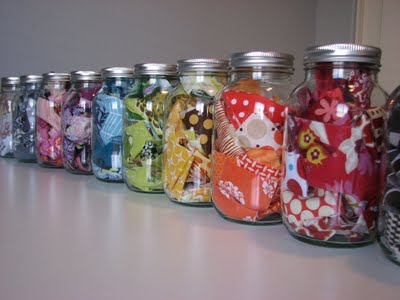To know if you have a
sewing addiction check these symptoms:
- You buy fabrics everywhere you go
- You buy fabrics even if you don't know what to do with them yet
- You have ecstatic visions of the clothes you'll make
If the descriptions above fit you your addiction has already gone too far. The consequences of this illness are mainly the build up of piles and piles of fabrics around the house. You filled chests then drawers and in acute crisis you can end up taking off the clothes from your closet to put fabrics in it.
If we can't cure your sewing addiction (please don't watch fashion shows to avoid serious crisis) we can at least cure its consequences. I'm here to suggest some clever
ways to store fabrics that will help you save space and money.
Do you have other ideas to store fabrics? I'd love to hear your solutions!
1. Hanging folders
The first
idea to organize fabrics I found on
Sew many ways is simply brilliant. Fabrics are rolled around hanging folders and stored in drawers as they were documents. Check out their webpage for the tutorial.
 |
| Isn't it clever? Fabric stored with hanging folders via Sew many ways |
2. Cloth hangers
The second
way to store fabrics is keep them in the closet on cloth hangers. This is a good idea because it keeps fabrics away from the daylight that is responsible of color fading. We can also use cloth hangers for scarfs in order to use all the vertical space we have.

3. Cardboard
This is the solution I'm going to use. Every piece of fabric is just rolled around a piece of cardboard and then stored on shelves. The cardboard makes the roll stiff so you can easily take it from a pile, it's a very inexpensive solution and since the fabric is tidily wrapped you can save space. The
Quilt board tells us how big is the piece of cardboard and
treasure 4 Tots shows us how to add a couple of tabs that keep the fabric in position. If you don't feel like
diy them you can even buy
fabric organizers here.
Mail organizer, cassette holder and jars
Storage solutions 4, 5 and 6 are for
fabric scraps. If you love patchwork techniques you'll have a lot of them. These are ways to store also all the remainder pieces of your
sewing projects. The author of
Living with kids stores her tiny pieces of fabrics into a mail organizer while
Tonya Staab uses a old cassette holder but nothing decorates more than jars filled with colored fabrics.
Per sapere se la febbre del cucito vi ha già contagiato controllate questi sintomi:
- Comprate stoffe dovunque andiate
- Quando vedete una stoffa che vi piace la comprate nonostante non sappiate ancora cosa farci
- Avete delle visioni sui vestiti che realizzerete
Se vi riconoscete in queste descrizioni siete ormai in uno stato acuto della malattia, uno stato dal quale non si può tornare indietro facilmente. Le conseguenze di questo disturbo sono principalmente l'accumulo di rotoli di stoffa per la casa. Vi capiterà di riempire mobili e scaffali. Sebbene non ci sia una cura precisa possiamo sempre curare i sintomi. Ecco a voi delle soluzioni creative ed economiche ai vostri cronici problemi di spazio.
1. Portadocumenti
L'autrice di
Sew many ways ha trovato un metodo intelligente per catalogare le sue stoffe usando nientemeno che dei portadocumenti. Le stoffe rimarranno così ordinate in un cassetto o in uno schedario.
2. Stampelle
Ebbene si usate le vostre stampelle per appendere le stoffe, quelle per le sciarpe vi auteranno ad utilizzare tutto lo spazio verticale a vostra disposizione. Le stoffe, tenute lontano dalla luce del sole non scoloriranno e si conserveranno meglio.
3. Cartoncini
Questa è la soluzione che personalmente ho deciso di adottare: è semplice da realizzare in casa e praticamente a costo zero. Le stoffe vengono piegate ordinatamente intorno ad un cartoncino e poi riposte negli scaffali. Il cartone rende la stoffa rigida quindi facile da estrarre da una pila. The
Quilt board ci illustra le dimensioni del cartoncino mentre
Treasure for Tots ci mostra come aggiungere delle alette che tengano ferma la stoffa.
Le soluzioni 4,5,6 sono per riporre ordinatamente pezzi di stoffa più piccoli, i cosidetti scampoli, rimanenze dei vostri progetti di cucito o materia prima per tecniche come il patchwork. L'autrice di Living with kids ripone gli scampoli in un portalettere mentre Tonya Staab opta per un vecchio portacassette. E che ne dite di riporre i pezzetti di stoffa nei barattoli? Diventeranno dei colorati elementi d'arredo.












































